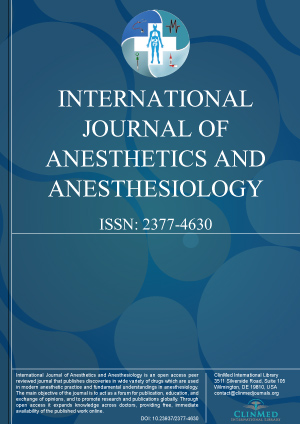Open Access DOI:10.23937/2377-4630/3/1/1043
Are Advertisement Claims in Anaesthetic Journals based on High-Quality Evidence?
Christian Zedler, Alexander Schnabel, Peter Kranke and Leopold Eberhart
Article Type: Original Article | First Published: February 26, 2016
Many medical journals contain advertisements for pharmaceuticals products. While the WHO demands that claims in pharmaceutical advertisements should be based on scientific evidence, past investigations demonstrated that some advertisements fail to fulfill these demands. As there is currently no investigation dealing with advertisements in anaesthetic journals, we aimed to find out whether claims in these journals are accompanied by references to external evidence, and whether these claims are su...
Open Access DOI:10.23937/2377-4630/3/1/1042
Integrated Pulmonary Index: A New Strategy for Respiratory Patients Evaluation
Guldem Turan, Yildiz Kuplay, Ceren Karip, Ceren Koksal, Cansu Akin and Nur Akgun
Article Type: Original Article | First Published: February 13, 2016
There are different monitorisation methods for following patients in intensive care units. Monitorisation of respiratory parameters is also important besides monitorisation of hemodynamic parameters. Integrated pulmonary index (IPI) algorithm incorporates four real-time respiratory measurements (end-tidal CO2, respiratory rate, pulse rate and SpO2) into a single value that represents respiratory profile including these parameters. IPI gives an idea to the clinician to determine the need for addi...
Open Access DOI:10.23937/2377-4630/3/1/1041
Anesthesiologists as Operating Room Directors: Results of a Survey
Steven Boggs, Elizabeth Frost and Jessica Feinleib
Article Type: Research Article | First Published: January 30, 2016
Many ideas have gone into the development of the concept of the Perioperative Surgical Home (PSH) and Enhanced Recovery after Surgery (ERAS). Many anesthesiologists have advocated for an increased role in operating room (OR) management, advancing from OR managers to OR directors with greater decision making and improved means of communication. However, there is little uniformity at present in the running of ORs around the country....
Open Access DOI:10.23937/2377-4630/3/1/1040
The Evaluation of 1-Physician Versus 2-Physician Deep Sedation with Propofol
Lindsay M Harmon, Anthony J Perkins, Beth Sandford and Christopher S Weaver
Article Type: Original Article | First Published: January 25, 2016
Emergency physicians routinely perform emergency department procedural sedation (EDPS) with propofol and its safety is well established. However, in 2009 the Centers for Medicare and Medicaid Services (CMS) enacted guidelines defining propofol as deep sedation and requiring administration by a physician. Common EDPS practice had been one-physician performing both the sedation and procedure. EDPS has proven safe under this 1-physician practice. However, the 2009 guidelines mandated separate physi...
Open Access DOI:10.23937/2377-4630/3/1/1039
Difficult Airway Management in Patients Submitted to General Anesthesia. Is it a Matter of Devices or Predictive Scores?
Lavinia Bergesio, Nadia Ruggieri, Orazio Difrancesco, Enrico Giustiniano and Franco Cancellieri
Article Type: Research Article | First Published: January 13, 2016
Airway management is mostly performed in the operating room, and unexpected difficult tracheal intubation may be a life-threatening event which incidence varies in a wide range with estimated pooled frequency of 6.8%. Difficulty at laryngoscopy or intubation, if inability to maintain a patient airway occurs, exposes the patient to the risk of complications basically related to hypoxia. Its incidence has been reported around 1-4% of patients with normal airway and, more recently, in a range of 1....

